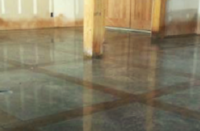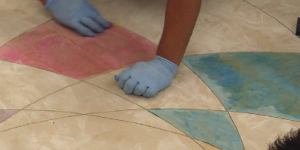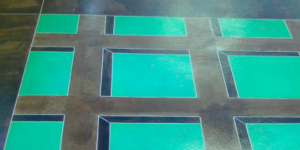
Who doesn’t like the look of stamped concrete? It can add a touch of elegance to everything from commercial and retail projects to public spaces and residences. But what if traditionally stamped concrete isn’t an option? What if the customer already has a concrete surface and a rip out isn’t in the budget? Or the space is difficult to access, making it a real challenge to remove broken slabs? In these scenarios, the solution may be a stamped concrete overlay.
Stamped concrete overlays have all the aesthetic advantages of conventional stamping or paving, but they’re easier and almost always less costly to install. All you need is a fairly decent slab foundation.
“It’s less labor-intense than a (regular) stamp job and more controllable,” says Mike McAnulty, president of Vegas Hardscape, a decorative concrete and coatings company in Las Vegas. “We’ve done a 600-square-foot patio in three days.”
The overlay advantage
Overlaying is simply a matter of laying a concrete topping of only a quarter-inch or so over an existing slab and stamping that new surface. Aesthetically, you can end up with the same coloring and texture that mimics the look of brick, stone, marble or whatever texture you’re after on a newly poured, thicker slab.
“Most of my residential customers have an existing concrete standard gray broom finish. I show them how it’s less expensive to install overlays than to tear out the existing concrete and start over,” says McAnulty. “I also see a lot of customers who prefer a rock look. But natural stone requires a lot more maintenance, so I show them how they can get the same effect with stamped overlays.”
Affordability is always an issue, and contractors who can overlay have a built-in advantage.
“We’re in western New York, and budgets are still tight whether it’s residential or commercial,” says Jim Boyce, operations manager at Rhino Concrete in Pittsford. “A lot of times people don’t really have the money to tear something out. But as long as it’s stable concrete, we can go over the top of it with the polymer concrete.”
Paul Koury, president of Westcoat Specialty Coating Systems in San Diego, calls downtime another factor. “Sometimes the motivation is turnaround, especially when it’s a commercial building or retail establishment,” he says. “You can’t be long out of service. It’s more expedient to go over the top as long as you have a good substrate.”
Koury also points out the environmental advantages of overlaying when there’s an existing slab. “There’s no reason to throw away 4 inches of concrete in the dump when you can make it look good again with a half-inch (or less) of concrete over the top,” he says.
Noe Serna, president of Southbay Decorative Concrete Supplies in Chula Vista, California, says that many of his customers raise eyebrows when the subject of overlays comes up.
“Most of the questions I get about the product have to do with the durability,” he says. “A lot of people are used to concrete and they can’t believe a quarter-inch overlay is going to hold up to factors like the weight of a car. I tell them it will last as long as the base. I’ve been playing with this product for about 14 years. I’ve used it inside my home and on my driveway. And I’ve got it in my store now, where we drive forklifts over it and I’ve never had a problem.”
Based on his southern California location, Koury says contractors sometimes push overlays because they’re working on difficult terrain. “California backyard pool decks might be a story or two lower in a canyon,” he says. “It’s difficult to pull out the existing concrete and figure out how to get it out of there. It can be much easier to overlay the top if it’s in good condition.”
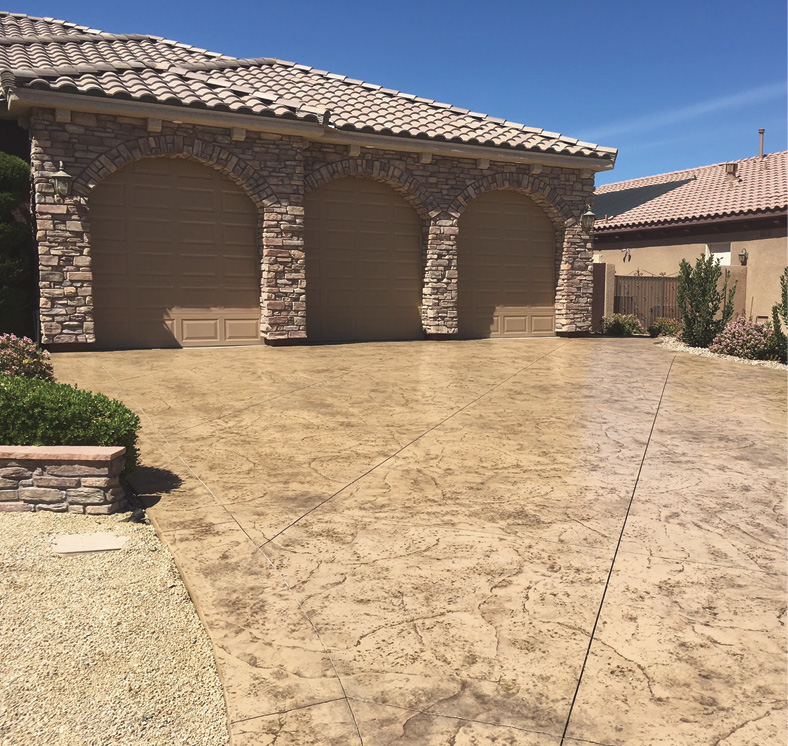
How to apply
Koury offers three simple words when outlining the key to job success with overlays: “Substrate, substrate, substrate.” The condition of the slab and the prep work done on it, he says, spell victory or doom.
“Make sure the substrate is on stable ground,” he says. “If you try to prep a bad substrate, it’s not going to get much better. The overlays can crack, too, just like regular concrete.”
That echoes the advice given by all our experts: invest your time wisely by carefully prepping.
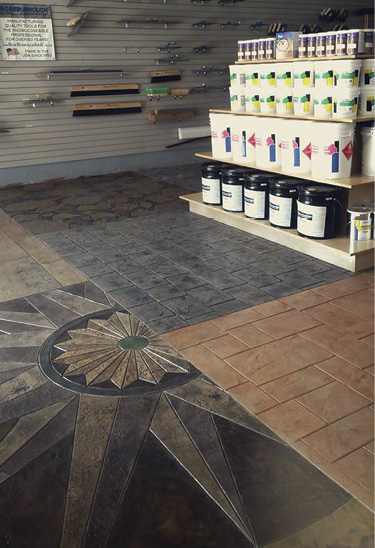
“We’ll go in one day and do the prep work, pressure washing and priming the slab,” says Boyce. “Then we’ll go in the next day and set up the mix station and, while one guy’s getting all the colors accurate, we’ll have two guys applying and one stamping. On the third day, it’s really a half day as far as going in and washing the slab down, getting it ready for sealing. Really, we can do a 600- to 800-foot space in a three-day process without any problem.”
During the prep stage, says McAnulty, “we’ll make sure there won’t be a moisture problem in the substratum. We’ll use a vapor barrier or a moisture control system if we think there might be. For assurance, we almost always use an epoxy with a full broadcast of sand as a primer after diamond grinding. We’ll conduct calcium chloride testing on interior concrete substrate jobs to test for moisture. We’ll also prepatch cracks, if necessary. Then we’ll start with diamond grinding the surface to take out surface stains and provide a good bond.”
For the overlay stage, McAnulty uses Westcoat TC-6, a dry polymer-based cement that comes in 50-pound bags. “We mix it with five quarts of water, and apply it to the surface with a 3/8-inch gauge rake to maintain consistency, and use a magic trowel and steel trowels to remove the gauge and spike shoe marks,” he says.
When it comes time for stamping, Boyce recommends a generous application of a liquid release first. “(The concrete mix is) almost a peanut-buttery consistency, so if you get on it too soon (stamping) or you don’t have enough release material applied, you’ll start pulling on it and the stamp will stick to it.”
Koury advises making sure all edges are terminated effectively and properly beveled. Tires ramming continuously against an unbeveled edge could crack the surface.

For coloring or tinting, you’ve got two basic options. “You can add integral color which is pretty simple now,” says Serna, adding that his store carries 20 to 30 different colors. “It comes in one bag and all you do is add water.”
The other way, he says, “is to get the overlay down and then dust the color onto the surface before stamping.”
Serna says that the integral colors are mostly available in the mid-range tones. If you’re looking for a color that’s particularly light or bold, you should go with the dusting method.
When it comes to coloring, Boyce advocates using one very experienced person to do all the mixing. “You don’t really want to start having multiple people mixing because they’ll get different colors and consistencies,” he says. “I want it to look like a stamped concrete hardscape, not like an overlay. If you don’t control your mixes you can get blotching really quickly and you’re not going to be able to get it out.”
Boyce adds additional steps to give his customers a more vintage look.
“Typically, we’ll add three or four different colors in our antiquing schemes to provide good depth on the overlays,” he says. “Especially on the wood (look). We’ll put two broad antiquings over the top and then I’ll go back and hand-antique the knots in for a realistic look.”
Do the job right, experts maintain, and you’ll end up with stamped concrete surfaces that fool the eye, please the wallet and win you referrals.

Training help available
You’ll find plenty of help online. Check out current training offerings at concretedecor.net and subscribe to our newsletter for updates. Tutorial videos are available at www.concretenetwork.com, www.butterfieldcolor.com and from various sources on YouTube. One-on-one training is also regularly available through Westcoat and Southbay. And the Concrete Decor Show is planning to host a stampable overlay workshop run by Stone Edge Surfaces (formerly Flex-C-Ment) in Florida this November.
In addition, Koury recommends reading International Concrete Repair Institute guidelines for concrete prep before applying toppings.
www.rhino-concrete.com
www.southbaydcs.com
www.vegashardscape.com
www.westcoat.com


